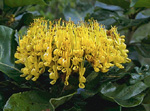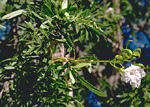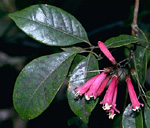 |
This is a relatively small, pantropical family, in Australia most commonly found in warm, lowland areas of the tropical north and east, but extending to moist forests of Victoria and Tasmania and (one species) into sheltered sites in the Central Australian ranges.
Characteristic features of the family Bignoniaceae in Australia include: - usually woody climbers (some are trees or shrubs) often with swollen stem nodes
- leaves opposite and pinnately or digitately compound (rarely simple or whorled)
- corolla showy, tubular and zygomorphic, usually with a curved tube, red, yellow or white, often spotted and hairy inside
- stamens in two unequal pairs
- fruit a 2-valved follicle containing many thin, winged seeds
Description
Evergreen or semi-deciduous trees, shrubs, or woody or herbaceous
vines climbing by hooks, tendrils, twining or scrambling stems. Tendrils
terminating leaves. Vegetative reproduction absent or by root suckers.
Stem nodes often conspicuously swollen. Internal secretions not obvious.
Plants glabrous or with simple, glandular or non-glandular hairs, unicellular
or uniseriate hairs. Leaves opposite, or in whorls 3 or 4, petiolate.
Stipules and stipellae absent. Lamina simple, once compound or bicompound;
bifoliolate, ternate, paripinnate or imparipinnate, symmetric; lamina/leaflets
filiform, acicular, subulate, linear, lanceolate, ovate, elliptic, oblanceolate
or obovate; base cuneate, attenuate or rounded; margins entire or serrate,
±flat; venation pinnate, with the midrib conspicuous, and the tertiary
venation reticulate or not; surfaces not punctate; herbaceous. Domatia
present. Plants with all the flowers bisexual. Inflorescences terminal
or axillary, consisting of racemes, panicles, dichasial cymes or solitary
flowers. Bracts and bracteoles present. Pollination by insects. Flowers
odourless or fragrant; stalked. Floral disc present; nectaries present
on the disc. Perianth of 2 dissimilar whorls. Calyx regular or irregular;
segments fused, with 5 lobes, imbricate or open in bud; calyx cup-shaped,
bell-shaped, funnel-shaped, spathate or tubular, herbaceous. Corolla irregular;
segments fused, with 5 lobes, alternating with the calyx lobes, imbricate
or valvate in bud, tubular or funnel-shaped, 2-lipped, with palate, or
curved-tubular, white, cream, yellow, red or pink, without contrasting
markings, or streaked, spotted, etc, membranous; claws absent; lobes ±entire
or notched. Fertile stamens 4, opposite to the calyx lobes, at least partly
fused to the corolla, free of ovary and style, distinct from each other
or in pairs. Staminodes 1 or absent. Anthers dorsifixed, not versatile,
opening inwards by longitudinal slits; 2- or 4- celled. Ovary superior
and sessile. Carpels 2, fused; ovary with 2 locules. Style terminal, single
and branched above, the branches sometimes flattened. Ovules numerous
per locules, stalked; placentation axile. Fruit a dry, dehiscent septicidal
or loculicidal capsule; the perianth on the maturing fruit deciduous.
Disseminule macro-surface winged; micro-surface ±smooth or tuberculate,
brown or grey, dull. Seeds numerous per fruit. Aril absent. Cotyledons
2. Embryo straight.
(Note: this description has been generated from the coded data compiled for the key. Any errors in the key data will be reflected in the descriptions.)
A treatment of the family Bignoniaceae has not yet been published in the Flora of Australia. It will appear in Volume 33.
Australian genera of Bignoniaceae (as recognised for the Flora of Australia)
* = all species introduced
Crescentia
Deplanchea
Dolichandrone
*Macfadyena
Neosepicaea
Pandorea
Parmentiera
*Pyrostegia
*Tecoma
Tecomanthe
Tecomaria

|
  |

Deplanchea tetraphylla (flowers)
Photo: J.Wrigley © ANBG

Dolichandrone heterophylla (flowering branch)
Photo: M.Fagg © M.Fagg

Neosepicaea jucunda (flowers)
Photo: H.Nicholson © H. & N. Nicholson

Neosepicaea viticoides (flowering branch)
Photo: H.Nicholson © H. & N. Nicholson

|

| |